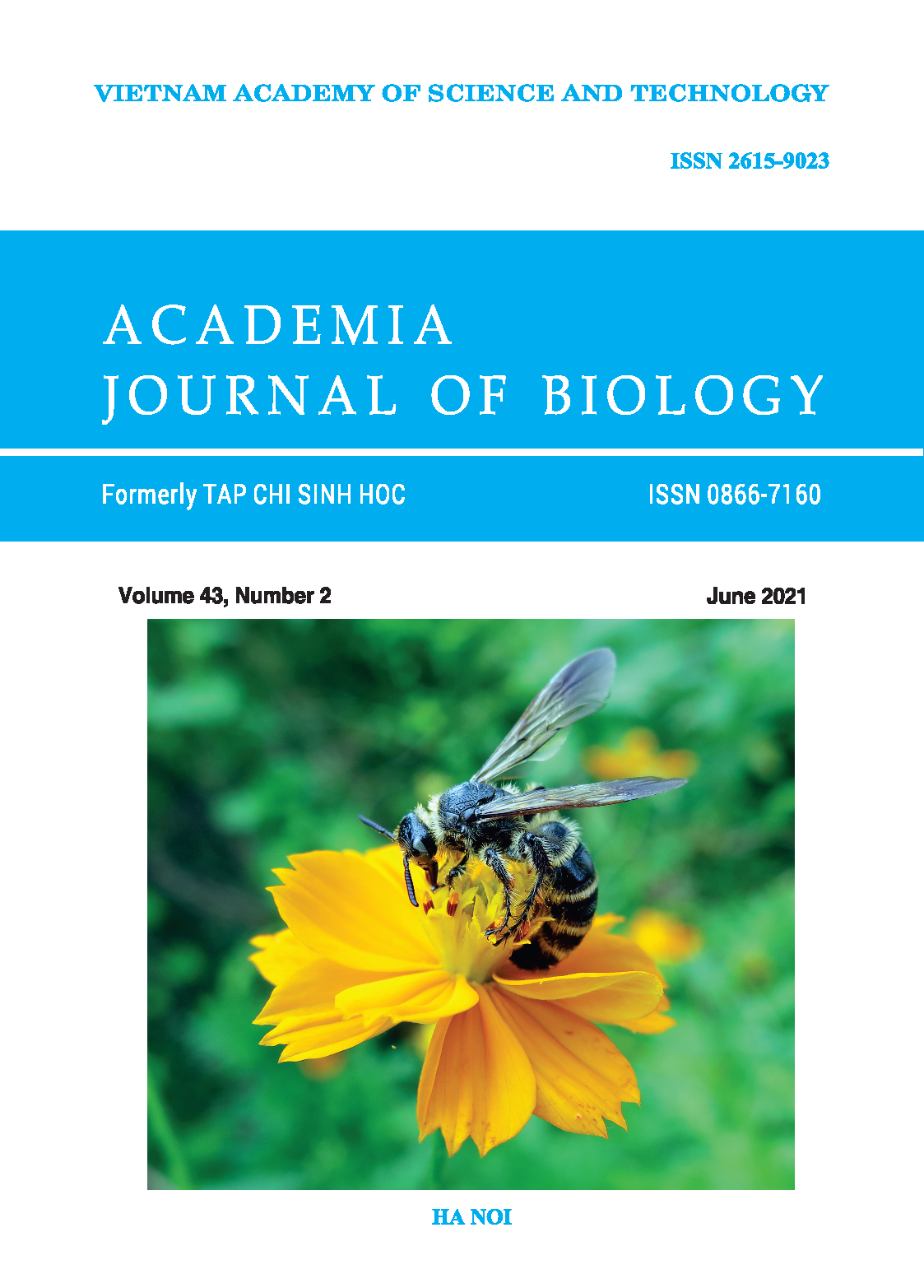Chemical composition and antimicrobial activity of essential oils from \(\textit{Angelica sinensis}\) (Oliv.) diels cultivated in Hung Yen province of Vietnam
Authors
DOI: https://doi.org/10.15625/2615-9023/15634Keywords:
Angelica sinensis, essential oil composition, antimicrobial activityReferences
Adams R. P., 2001. Identification of essential oil components by gas chromatography, quadrupole mass spectroscopy. Carol Stream, Ill.: Allured Publishing Corporation; 3rd edition. ISBN: 0931710855, pp. 456.
Champakaew D., Junkum A., Chaithong U., Jitpakdi A., Riyong D., Sanghong R., Intirach J., Muangmoon R., Chansang A., Tuetun B., Pitasawat B., 2015. Angelica sinensis (Umbelliferae) with proven repellent properties against Aedes aegypti, the primary dengue fever vector in Thailand. Parasitology Research, 114: 2187–2198.
Chao W. W. and Lin B. F., 2011. Bioactivities of major constituents isolated from Angelica sinensis (Danggui). Chinese Medicine, 6: 29.
Chen S. W., Min L., Li W. J., Kong W. X., Li J. F., Zhang Y. J., 2004. The effects of Angelica essential oil in three murine tests of anxiety. Pharmacology Biochemistry and Behavior, 79: 377–382.
Cos P., Vlietinck A. J., Berghe D. V., Maes L., 2006. Anti-infective potential of nature products: How to develop a stronger in vitro ‘proof-of-concept’. Journal of Ethnopharmacology, 106(3): 290–302.
Do H. B., Dang Q. C., Bui X. C., Nguyen T. D., Do T. D., Pham V. H., Vu N. L., Pham D. M., Pham K. M., Doan T. N., Nguyen T., Tran T., 2004. Medicinal plants and animals in Vietnam. Vol. 1. Science and Technolgy Publishing House, pp.1138 (in Vietnamese).
Hadacek F., Greger H., 2000. Testing of antifungal natural products methodologies, comparability of result and assay choice. Phytochemical Analysis, 11: 137–147.
König W. A., Joulain D., Hochmuth D. H., 2019. Terpenoids library - Terpenoids and related constituents of essential oils. https://massfinder.com/wiki/Terpenoids_Library (accessed: April 12, 2020)
Kuang X., Du J. R., Liu Y. X., Zhang G. Y., Peng H. Y., 2008. Postischemic administration of Z-Ligustilide ameliorates cognitive dysfunction and brain damage induced by permanent forebrain ischemia in rats. Pharmacology Biochemistry and Behavior, 88(3): 213–221. https://doi.org/10.1016/j.pbb.2007.08.006
Li J., Hua Y., Ji P., Yao W., Zhao H., Zhong L., Wei Y., 2016. Effects of volatile oils of Angelica sinensis on an acute inflammation rat model. Pharmaceutical Biology, 54: 1881–1890.
Li S. Y., Yu Y., Li S. P., 2007. Identification of antioxidants in essential oil of radix Angelicae sinensis using HPLC coupled with DAD-MS and ABTS-based assay. Journal of Agricultural and Food Chemistry, 55: 3358−3362.
Linstrom P. J. and Mallard W. G., 2020. NIST chemistry webbook, NIST standard reference database number 69, National Institute of Standards and Technology, Gaithersburg M. D., 20899, https://doi.org/10.18434/T4D303 (accessed: April 12, 2020)
Liu L. S., Peng C., Zhou Q. M., Xiong L., Guo L., Wang Y. N. and Dai O., 2017. Effects of angelica oil and the isolated butylphthalides on glutamate-induced neurotoxicity in PC12 cells. Records of Natural Products, 11(2): 217–222.
Ministry of Health, 2009. Vietnam Pharmacopoeia IV. Medical Publishing House, Hanoi, Vietnam., pp. 962 (in Vietnamese).
Mullen K. A., Lee A. R., Lyman R. L., Mason S. E., Washburn S. P., Anderson K. L., 2014. Short communication: An in vitro assessment of the antibacterial activity of plant-derived oils. Journal of Dairy Science, 97: 5587–5591.
Nguyen X. D., Luu D. C., La D. M. & Leclercq P. A., 1996. Composition of the leaf and flower oils from Angelica sinensis (Oliv.) Diels cultivated in Vietnam. Journal of Essential Oil Research, 8(5): 503–506.
Peng H. Y., Du J. R., Zhang G. Y., Kuang X., Liu Y. X., Qian Z. M., and Wang C. Y., 2007. Neuroprotective effect of Z-ligustilide against permanent focal ischemic damage in rats. Biological and Pharmaceutical Bulletin, 30(2): 309–312.
Tabanca N., Wedge D. E., Wang X., Demirci B., Baser K. H. C., Zhou L. and Cutler S. J., 2008. Chemical composition and antifungal activity of Angelica sinensis essential oil against three Colletotrichum species. Natural Product Communications, 3(7): 1073–1078.
Vo V. C., 2012. Vietnamese medicinal plant dictionary. Vol. 1. Medical Publishing House.
Wedge D. E., Klun J. A., Tabanca N., Demirci B., Ozek T., Baser K. H. C., Liu Z., Zhang S., Cantrell C. L., Zhang J., 2009. Bioactivity-guided fractionation and GC/MS fingerprinting of Angelica sinensis and Angelica archangelica root components for antifungal and mosquito deterrent activity. Journal of Agricultural and Food Chemistry, 57: 464–470.
Wedge D. E., Tabanca N., Demirci B., Ozek T., Baser K. H. C., Klun J. A., Liu Z., Zhang S., Cantrell C. L., Zhang J. K., 2008. GC-MS fingerprinting of Angelica sinensis and A. archangelica root components and mosquito deterrent activity. Planta Medica, 74(03): 361–361.
Yao W., Zhang L., Hua Y., Ji P., Li P., Li J., Zhong L., Zhao H., Wei Y., 2015. The investigation of anti-inflammatory activity of volatile oil of Angelica sinensis by plasma metabolomics approach. International Immunopharmacology, 29: 269–277.
Downloads
Metrics
Downloads
PDF Downloaded: 141





